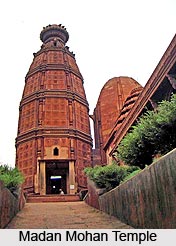 Vrindavan, around 15 km from Mathura district of Uttar Pradesh, is a little town and a major place of pilgrimage on the banks of Yamuna River. Mathura is a sacred place and is visited by many pilgrims. Attracting about 500,000 pilgrims every year, mainly during major festivals like Janmashtami, Holi and Radhashtami, it is noted for its numerous temples both, old and modern, big and small. Hinduism is the dominant religion of the place.
Vrindavan, around 15 km from Mathura district of Uttar Pradesh, is a little town and a major place of pilgrimage on the banks of Yamuna River. Mathura is a sacred place and is visited by many pilgrims. Attracting about 500,000 pilgrims every year, mainly during major festivals like Janmashtami, Holi and Radhashtami, it is noted for its numerous temples both, old and modern, big and small. Hinduism is the dominant religion of the place.
Vrindavan lies in the Braj region and is rooted in rich mythological past. It is said to be the region where Lord Krishna have spent his childhood. Vrindavan is also associated with Hindu folklore and is an important Hindu pilgrimage site. The major tradition followed in the area is Vaishnavism, and it is a center of learning with many Vrindavan Ashrams operating. In a centuries-old tradition Hindu widows have been coming to live out the rest of their lives in Vrindavan. They are expected to shed all physical adornments, including long hair, wear only white cotton saris and lead an austere lifestyle. Subsisting on charitable donations made by wealthy traders, the widows pass their life in devotion to Krishna, the Supreme Lord.
Temple Architecture at Vrindavan
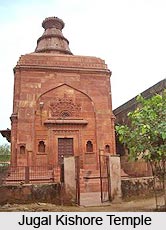 Most of the temples in Vrindavan belong to the North Indian style of temple architecture, while a few conform to a mixed style. The temples now present in Vrindavan were constructed after 1000 AD, while some of them are of recent origin.
Most of the temples in Vrindavan belong to the North Indian style of temple architecture, while a few conform to a mixed style. The temples now present in Vrindavan were constructed after 1000 AD, while some of them are of recent origin.
The main architectural creations of the place are temples, of which the main temples are the Madan Mohan Temple, the famous Radha Vallav Temple, the Jugal Kishore Temple, the Jaipur Temple, the Shahji Temple, the Rangaji Temple and the Govind Deo Temple. Buddhist and Jain temples were built here during ancient times but were later destroyed. Islamic architectural styles have crept into the design, making it a unique structure.
Madan Mohan Temple
Madan Mohan Temple on the riverside is the oldest structure in Vrindavan. This 60 foot high temple was opened in 1580 on a 50 foot hill called Dvadasaditya Tila, next to the Yamuna. The architecture of the Madan Mohan temple is similar to that of the Jagat Kishore temple. The wall of the octagonal shikhara is done in lattice work and a medallion has been installed, but there is no statue within.
Jugal Kisore Temple
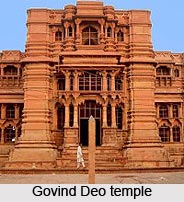 Jugal Kisore Temple is one of the oldest temples of Vrindavan, constructed with the Yamuna River at the rear and the old Ghats as a backdrop in 1627. Earlier, the temple had an open porch in front. Carved on the tympanum above the entrance are Krishna and other animal forms worshipped by Hindus. It is sometimes called the Kesi ghata temple, as it is located next to this ghata.
Jugal Kisore Temple is one of the oldest temples of Vrindavan, constructed with the Yamuna River at the rear and the old Ghats as a backdrop in 1627. Earlier, the temple had an open porch in front. Carved on the tympanum above the entrance are Krishna and other animal forms worshipped by Hindus. It is sometimes called the Kesi ghata temple, as it is located next to this ghata.
Govind Deo Temple
Govind Deo Temple was a grand seven-story structure, with an altar of marble, silver and gold. Architecturally this temple is one of the finest in North India. A sculptured lotus flower weighing several tons decorates the main hall ceiling. With its many arches and no sculptures to adorn it, the Mandapa looks like a mosque. The sides of the building and the balcony, have traditional framework, which gives the temple a rich look. It was built in 1590 by Raja Man Singh from Jaipur, a general in Akbar"s army. Akbar himself had donated the red sandstone for its construction. In 1670, during the rule of a later Mughal king, Aurangzeb, it was plundered and destroyed leaving only three stories of the original temple.
Jaipur Temple
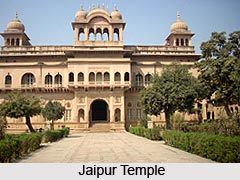 Jaipur Temple, one of Vrindavan"s most opulent temples, was built by the Maharaja of Jaipur, Sawai Madhav, in 1917 after 30 years of labor. The fine hand-carved sandstone is of unparalleled workmanship, the huge pillars that hold up the roof are each carved from one solid rock, and the intricately fashioned marble on the altar is reminiscent of the Mughal period.
Jaipur Temple, one of Vrindavan"s most opulent temples, was built by the Maharaja of Jaipur, Sawai Madhav, in 1917 after 30 years of labor. The fine hand-carved sandstone is of unparalleled workmanship, the huge pillars that hold up the roof are each carved from one solid rock, and the intricately fashioned marble on the altar is reminiscent of the Mughal period.
Shahji Temple
Shahji Temple, another popular temple at Vrindavan, was designed and built in 1876 by a wealthy jeweler, Shah Kundan Lal of Lucknow. Noted for its magnificent architecture and beautiful marble sculpture, the temple has twelve spiral columns each 15 feet high. The "Basanti Kamra" - the darbar hall is famed for its Belgian glass chandeliers and fine paintings.
Rangaji Temple
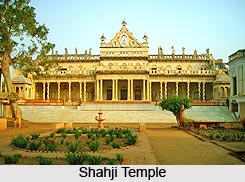 Opposite from the Govinda Dev Temple is an imposing south-Indian temple called Rangaji Temple. It is 30 meters high with three gopurams (gateways), a tall shikhara (crown) and gold-plated decorations. This temple has a traditional South Indian gopuram, a Rajput-styled entrance gate and an Italian-influenced colonnade. One of the enclosures within the precincts of this magnificent temple has a 15-meter-high pillar made of gold. It is one of Vrindavan"s largest temples and is surrounded by high walls.
Opposite from the Govinda Dev Temple is an imposing south-Indian temple called Rangaji Temple. It is 30 meters high with three gopurams (gateways), a tall shikhara (crown) and gold-plated decorations. This temple has a traditional South Indian gopuram, a Rajput-styled entrance gate and an Italian-influenced colonnade. One of the enclosures within the precincts of this magnificent temple has a 15-meter-high pillar made of gold. It is one of Vrindavan"s largest temples and is surrounded by high walls.
Other places of architectural interest comprise Seva Kunj, Jugal Kishore Temple, Kesi Ghat, Sriji Temple, Lal Babu Temple, Meera-Bai Temple, Raman Reti, Varaha Ghat and Chira Ghat. With this enormous collection of architectural specimens, Vrindavan is a coveted tourist spot.



















